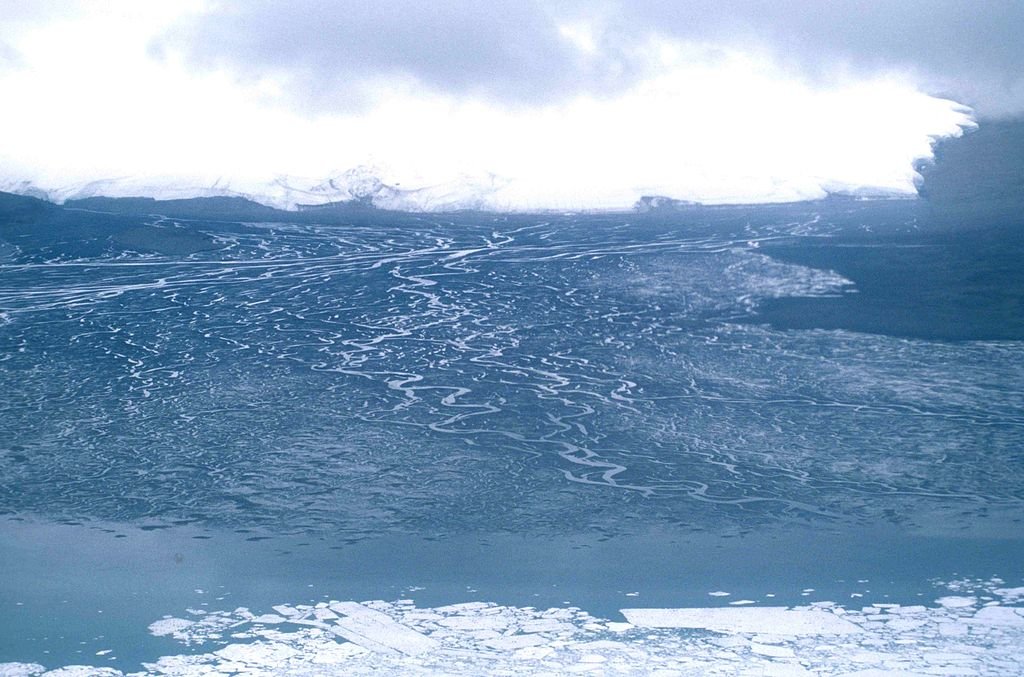
Mercury is a contaminant which poses environmental health risks to terrestrial and aquatic ecosystems around the world, especially in the Arctic. A recent study in Environmental Science & Technology traces the source of mercury concentrations in Lake Hazen to increased flow in glacial rivers. Lake Hazen, located in Nunavut, Canada, is the High Arctic’s largest lake by volume, and reaches depths up to 267m.
There are both natural and anthropogenic sources of mercury. Global mercury emissions have been declining, specifically after ratification of the Minamata Convention. However, as anthropogenic sources decrease, climate change could be increasing natural sources of mercury—if in a less direct fashion than emissions.
Mercury is stored in permafrost and glacial ice, so as permafrost thaws and ice melts, downstream ecosystems could be impacted. Microbes can also transform mercury into a poisonous neurotoxin called methylmercury, which impacts the nervous system. Both can bioaccumulate in organisms, especially at higher levels of the food chain.
“The primary focus of the research program at Lake Hazen is on understanding the biogeochemistry of freshwater ecosystems downstream of the glaciers of the Northern Ellesmere Icefield,” said Kyra St. Pierre, the study’s lead author, in an interview with GlacierHub. St. Pierre, who conducted this research as a part of the Department of Biological Sciences at the University of Alberta, Canada, went on to say that the study aimed to explain how recent warming patterns might impact biogeochemical cycles in the future.
Lake Hazen receives meltwater—and up to 94 percent of total mercury inputs—primarily from three glacial rivers. The study showed that most mercury from these rivers flowed into the lake in particulate form. This means that the particles carrying mercury are not dissolved, making the water flowing into Lake Hazen more turbid, or cloudy, than the lake’s existing water. Due to the weight of the particles it carries, turbid water is also very dense. The increased weight creates what is called a turbidity current, which efficiently deposits most of the mercury particles in the bottom of the lake.

St. Pierre named these turbidity currents the study’s most surprising result, because it revealed important aspects of how Lake Hazen’s watershed functions. “Not only do [turbidity currents] transport mercury from the surface but also oxygen and other nutrients directly to the depths of the lake,” she said.
This study is distinctive in that it approached mercury cycling at a watershed-scale instead of looking at individual system components. St. Pierre called this one of the study’s most important attributes, explaining that if, for example, they had decided to focus simply on Lake Hazen’s outflows, they would have concluded that mercury concentrations were extremely low.
Lake Hazen’s turbidity currents make it a huge mercury sink. Despite huge mercury inputs from glacial rivers, the lake’s main outflow, the Ruggles River, discharges relatively small amounts of mercury and methylmercury. The researchers found that the lake sequestered over 95 percent of total mercury inputs to the system annually. Downstream in the Ruggles River, mercury concentrations rose exponentially, a result of erosion and thawing permafrost.
The High Arctic is extremely sensitive to increasing temperatures and precipitation in the context of anthropogenic climate change. Craig Emmerton and Jennifer Graydon, researchers at the University of Alberta, spoke to GlacierHub about some of the larger implications of this study. “The High Arctic is among the most rapidly changing regions on Earth and its climate is expected to become warmer and wetter,” they said, pointing out the potential role of glaciers and permafrost as developing sources of mercury with the power to contaminate freshwater and marine ecosystems.
“I think we can safely infer that as warming continues in High Arctic latitudes, we can expect a greater delivery of mercury from the cryosphere to downstream ecosystems,” said St. Pierre. Though Lake Hazen retains most mercury inputs from glacial rivers, the researchers found a 3.4-times greater water volume and 2-times higher delivery of total mercury in the notably warm summer of 2015, than in the much cooler summer of 2016. So, as glaciers continue to melt, more mercury will inevitably make its way downstream.
Lake Hazen’s depth and size draw close similarities to High Arctic fjord systems. The researchers showed that these turbidity currents also occur in fjords indirectly fed by land-terminating glaciers. Almost 70 percent of arctic glaciers are land-terminating glaciers, and so could be important sources of mercury for marine ecosystems. More, fjords fed by marine-terminating glaciers can flow directly into high productivity zones, increasing potential for bioaccumulation in organisms and into coastal food webs.
Ultimately, this study highlights an important discovery—even with reduction of direct anthropogenic sources of mercury, there is a lingering, growing anthropogenic driver—climate change.


